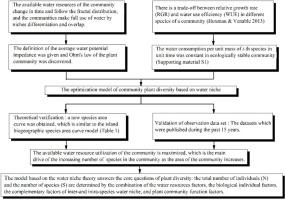当前位置:
X-MOL 学术
›
Ecol Modell
›
论文详情
Our official English website, www.x-mol.net, welcomes your
feedback! (Note: you will need to create a separate account there.)
Quantification of water resource utilization efficiency as the main driver of plant diversity in the water-limited ecosystems
Ecological Modelling ( IF 2.6 ) Pub Date : 2020-08-01 , DOI: 10.1016/j.ecolmodel.2020.108974 Zhi-Quan Han , Tong Liu , Tao Wang , Hua-Feng Liu , Xiao-Ran Hao , Yi-Neng Ouyang , Bo Zheng , Bai-Lian Li
Ecological Modelling ( IF 2.6 ) Pub Date : 2020-08-01 , DOI: 10.1016/j.ecolmodel.2020.108974 Zhi-Quan Han , Tong Liu , Tao Wang , Hua-Feng Liu , Xiao-Ran Hao , Yi-Neng Ouyang , Bo Zheng , Bai-Lian Li

|
Abstract Identifying the drivers of species richness is a crucial for biodiversity conservation and community ecology. In this paper, the maximum utilization efficiency of water resources available to community is determined as the assembly law in an ecologically stable community with limited water resources. A plant community diversity model that incorporates water potential impedance is established, and the optimization model of community biodiversity structure was obtained based on water niche is also derived. It is shown that this optimization model can theoretically derive a species-area function similar to the traditional island biogeography curve, and it can also verify the predicted values of the species-area relationship experimentally and validated by long-term observations of plant diversity survey data. According to the model analyses, the total number of individuals (N) and the number of species (S) are determined by the combination of the water resources factors (the total quantity of available water resources in the growth season), the individual biological factors (the water consumption per unit mass of species in unit time), the complementary factors of inter- and intra-species water niche (the difference in water potential depending on the water use efficiency of the community), and plant community function factors (the total productivity of plant community). And as the area of plant communities increases, the heterogeneity of the water environment has increased. By adaptation and coevolution, more species are able to go through environmental and biological filtration, becoming community species that can utilize more available water resources at different spatial scales. Changes in water resources resulted in the community maximizing the utilization efficiency of water resources by adjusting the number and abundance of species. The main driving force for the increasing number of species is the full utilization of available water resources.
中文翻译:

水资源利用效率的量化作为缺水生态系统中植物多样性的主要驱动力
摘要 确定物种丰富度的驱动因素对于生物多样性保护和群落生态至关重要。本文将社区可用水资源的最大利用效率确定为水资源有限的生态稳定社区的集会规律。建立了考虑水势阻抗的植物群落多样性模型,推导出了基于水位生态位的群落生物多样性结构优化模型。结果表明,该优化模型在理论上可以推导出类似于传统岛屿生物地理学曲线的物种-面积函数,也可以通过实验验证物种-面积关系的预测值,并通过植物多样性调查数据的长期观察进行验证。 . 根据模型分析,个体总数(N)和物种总数(S)由水资源因素(生长季节可用水资源总量)、个体生物因素(单位用水量)共同决定。单位时间内的物种质量)、物种间和物种内水位的互补因子(水势差异取决于群落的水分利用效率)、植物群落功能因子(植物群落的总生产力) . 并且随着植物群落面积的增加,水环境的异质性也增加了。通过适应和共同进化,更多的物种能够通过环境和生物过滤,成为能够在不同空间尺度上利用更多可用水资源的群落物种。水资源的变化导致群落通过调整物种的数量和丰度来最大化水资源的利用效率。物种数量增加的主要驱动力是对可用水资源的充分利用。
更新日期:2020-08-01
中文翻译:

水资源利用效率的量化作为缺水生态系统中植物多样性的主要驱动力
摘要 确定物种丰富度的驱动因素对于生物多样性保护和群落生态至关重要。本文将社区可用水资源的最大利用效率确定为水资源有限的生态稳定社区的集会规律。建立了考虑水势阻抗的植物群落多样性模型,推导出了基于水位生态位的群落生物多样性结构优化模型。结果表明,该优化模型在理论上可以推导出类似于传统岛屿生物地理学曲线的物种-面积函数,也可以通过实验验证物种-面积关系的预测值,并通过植物多样性调查数据的长期观察进行验证。 . 根据模型分析,个体总数(N)和物种总数(S)由水资源因素(生长季节可用水资源总量)、个体生物因素(单位用水量)共同决定。单位时间内的物种质量)、物种间和物种内水位的互补因子(水势差异取决于群落的水分利用效率)、植物群落功能因子(植物群落的总生产力) . 并且随着植物群落面积的增加,水环境的异质性也增加了。通过适应和共同进化,更多的物种能够通过环境和生物过滤,成为能够在不同空间尺度上利用更多可用水资源的群落物种。水资源的变化导致群落通过调整物种的数量和丰度来最大化水资源的利用效率。物种数量增加的主要驱动力是对可用水资源的充分利用。









































 京公网安备 11010802027423号
京公网安备 11010802027423号